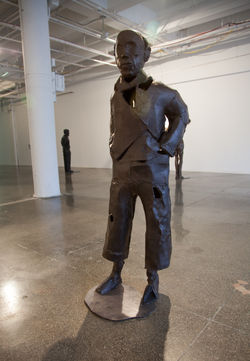Three painters, a rock star, a young girl, and a psychoanalyst in one room
As if grown nearly fully formed fresh out of the soil, Eran Shakine’s iconic figures stand on uncertain wobbly legs looking much as if they might be reabsorbed into the earth.
The seven new sculptures here are all black, all hard-shelled cast aluminium and bronze, but they show their clay origins, the hand marks of their creator, in the softness and irregularities of their surfaces. And all of the works have holes in them so you can see inside, rendering them, in effect, shells to be filled with our own perceptions. Are they both less and more than meet the eye? Shakine asks: What makes a hero? What is the nature of celebrity? Do cultural, political, intellectual, and artistic figures have qualities in common? Is there something about them, or even more, something about us, that needs to makes them heroic? How are our times and culture reflected in our choice of heroes? Do we understand these icons differently from different historical perspectives?
The answer to everything is, Yes! At the same time, Shakine insists, “They are very much about now.” Standing on the floor on stainless-steel plates, the sculptures are all positioned with their back to the center of the room facing the empty white wall, as if partaking of a Tibetan meditation. “What are they looking at?” Shakine leaves us to wonder. Are they inviting us to join the circle? “You can’t control what people see,” he observes. But in perceiving the figures this way, we can be drawn into their group, forced to see them as they see us. These are specific individuals who attain universality in the tentativeness of existence. Shakine is not interested so much in their individual personalities as he is in “what the person means in our culture.”
Cocky characters are rendered as vulnerable. Here is Mick Jagger emerging from a quick sculptural sketch; Jackie Kennedy is portrayed soft, stripped of her impenetrable veneer; Picasso is a figure of bravado, his clothing patched together but his stance well-balanced. Van Gogh and Gauguin, recurring partners in Shakine’s repertoire, whether drawn or sculpted, continue to be the subject of endless speculation for him: Van Gogh’s relationship with Gauguin, feelings of insecurity, a romantic bond, a broken one, a psychosis? In one of the sculptures Shakine rendered the two artists as physically connected. With information derived from research, from Google, from historical gossip, and psychological speculation, these artists are forever linked in Shakine’s imagination.
Stationed among the strong, albeit enigmatic, males is Alice-a young woman standing on the floor, taller than all the other heroes. For Shakine, she “speaks of the position of women in society.” She could be part “Alice in Wonderland,” part “Alice Doesn’t Live Here Anymore,” part everywoman. Meanwhile, Sigmund Freud, a formidable presence here--dour, unrevealing, and not quite judgmental--holds it all together, looking less exposed than the rest. Timely as well as timeless, the characters’ uniform blackness together with their underlying flirtation with abstraction absorb much of their individuality. They are repositories of our own cultural and individual imaginations and expectations, just as they create them. But they distinguish themselves most by their forthright open-endedness and willingness to entertain all questions and answers. Shakine’s “heroes” partake of the present, the art historical, and the fictive. Ultimately, all of the figures are at once representations of and inquiries into how we define the world itself as well as what it means to be a hero.
Barbara MacAdam
Co-Executive Editor, ARTnews Magazine
 Mick, 2015, self dry clay and Stainless Steel, 50 x 17 x 13 cm |  |  Mick, 2015, self dry clay and Stainless Steel, 50 x 17 x 13 cm |
|---|---|---|
 A Muslim, a Christian and a Jew Feeling that they were being watched 2016, oil on canvas, 160×140 cm. |  Pablo Picasso, 2015, Bronze with Polished Black Patina and Stainless Steel, h 165 cm |  MCJ, oil on canvas, 150×100 cm. |
 A young girl, 2015, Bronze with Polished Black Patina and Stainless Steel, h 200 cm |  MCJ, oil on canvas, 110×80 cm. |  Mick, 2015, self dry clay and Stainless Steel, 50 x 17 x 13 cm |














